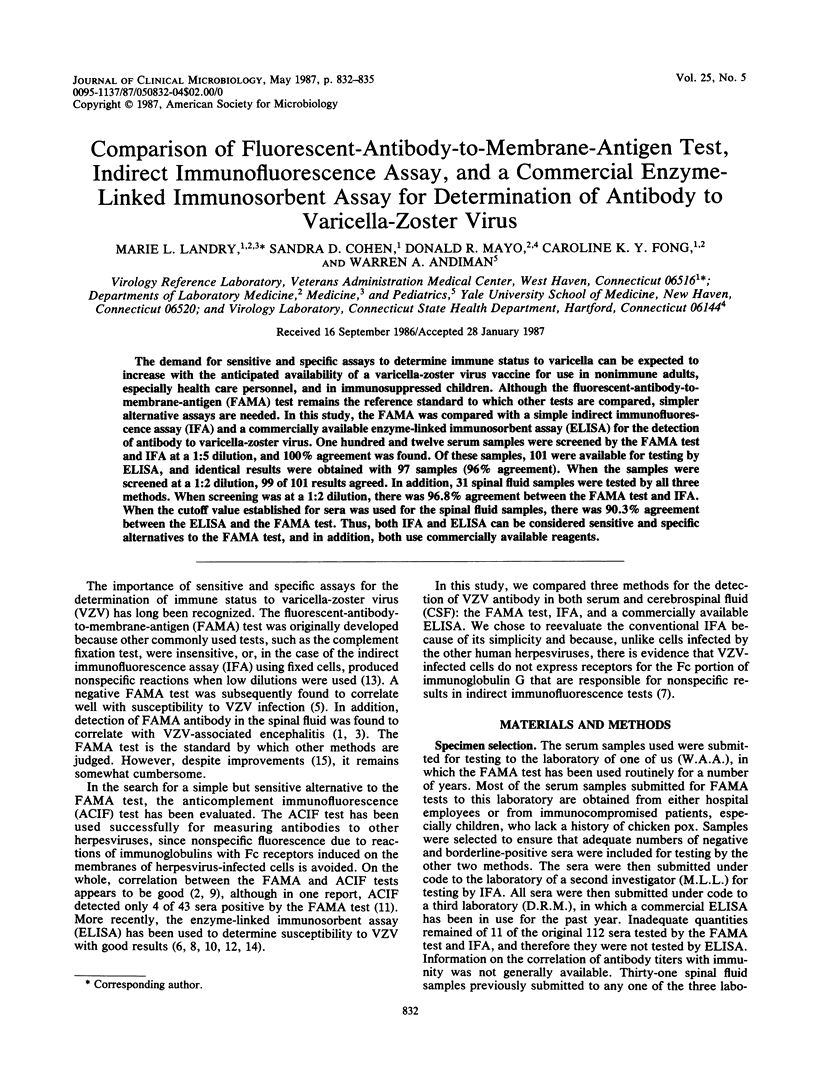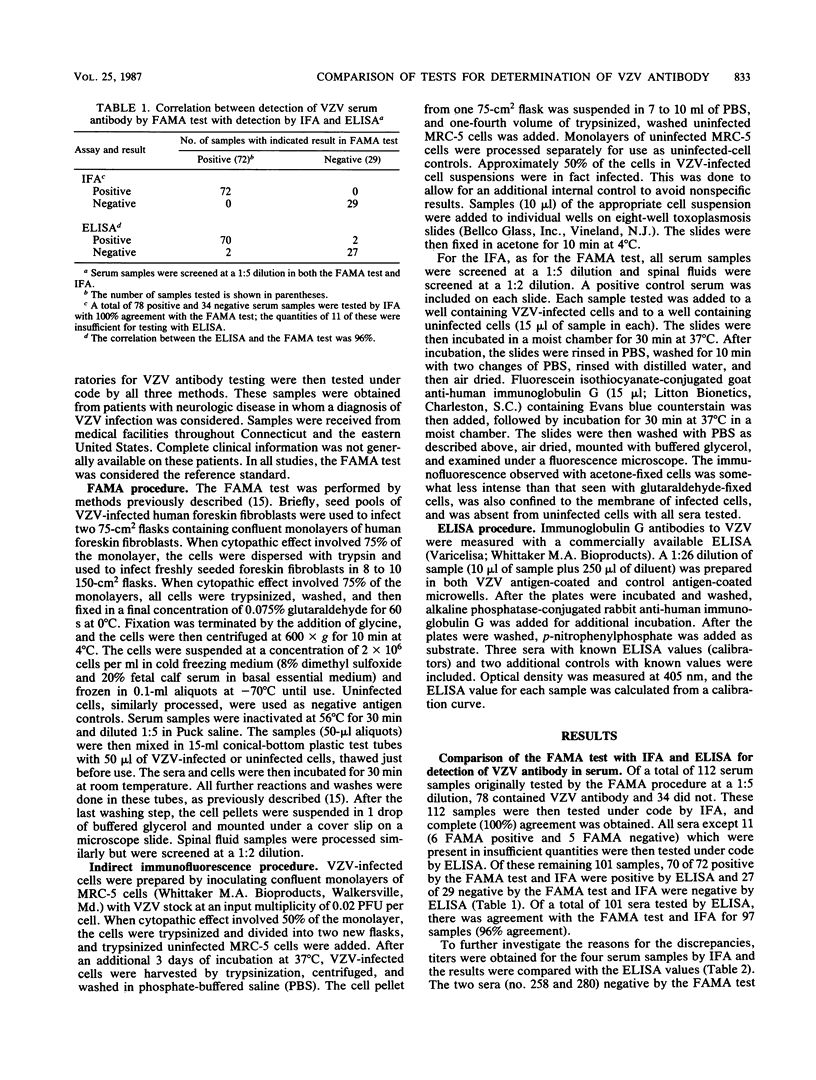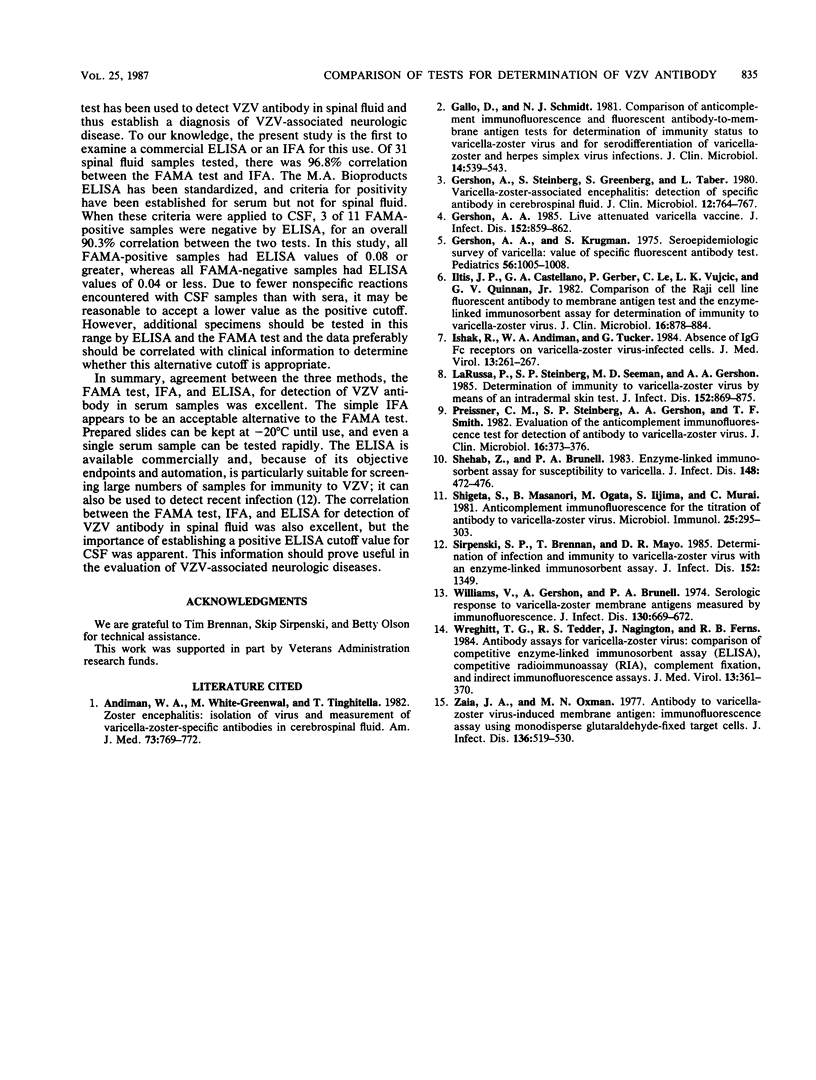Abstract
The demand for sensitive and specific assays to determine immune status to varicella can be expected to increase with the anticipated availability of a varicella-zoster virus vaccine for use in nonimmune adults, especially health care personnel, and in immunosuppressed children. Although the fluorescent-antibody-to-membrane-antigen (FAMA) test remains the reference standard to which other tests are compared, simpler alternative assays are needed. In this study, the FAMA was compared with a simple indirect immunofluorescence assay (IFA) and a commercially available enzyme-linked immunosorbent assay (ELISA) for the detection of antibody to varicella-zoster virus. One hundred and twelve serum samples were screened by the FAMA test and IFA at a 1:5 dilution, and 100% agreement was found. Of these samples, 101 were available for testing by ELISA, and identical results were obtained with 97 samples (96% agreement). When the samples were screened at a 1:2 dilution, 99 of 101 results agreed. In addition, 31 spinal fluid samples were tested by all three methods. When screening was at a 1:2 dilution, there was 96.8% agreement between the FAMA test and IFA. When the cutoff value established for sera was used for the spinal fluid samples, there was 90.3% agreement between the ELISA and the FAMA test. Thus, both IFA and ELISA can be considered sensitive and specific alternatives to the FAMA test, and in addition, both use commercially available reagents.
Full text
PDF



Selected References
These references are in PubMed. This may not be the complete list of references from this article.
- Andiman W. A., White-Greenwald M., Tinghitella T. Zoster encephalitis. Isolation of virus and measurement of varicella-zoster-specific antibodies in cerebrospinal fluid. Am J Med. 1982 Nov;73(5):769–772. doi: 10.1016/0002-9343(82)90422-3. [DOI] [PubMed] [Google Scholar]
- Gallo D., Schmidt N. J. Comparison of anticomplement immunofluorescence and fluorescent antibody-to-membrane antigen tests for determination of immunity status to varicella-zoster virus and for serodifferentiation of varicella-zoster and herpes simplex virus infections. J Clin Microbiol. 1981 Nov;14(5):539–543. doi: 10.1128/jcm.14.5.539-543.1981. [DOI] [PMC free article] [PubMed] [Google Scholar]
- Gershon A. A., Krugman S. Seroepidemiologic survey of varicella: Value of specific fluorescent antibody test. Pediatrics. 1975 Dec;56(6):1005–1008. [PubMed] [Google Scholar]
- Gershon A. A. Live attenuated varicella vaccine. J Infect Dis. 1985 Nov;152(5):859–862. doi: 10.1093/infdis/152.5.859. [DOI] [PubMed] [Google Scholar]
- Gershon A., Steinberg S., Greenberg S., Taber L. Varicella-zoster-associated encephalitis: detection of specific antibody in cerebrospinal fluid. J Clin Microbiol. 1980 Dec;12(6):764–767. doi: 10.1128/jcm.12.6.764-767.1980. [DOI] [PMC free article] [PubMed] [Google Scholar]
- Iltis J. P., Castellano G. A., Gerber P., Le C., Vujcic L. K., Quinnan G. V., Jr Comparison of the Raji cell line fluorescent antibody to membrane antigen test and the enzyme-linked immunosorbent assay for determination of immunity to varicella-zoster virus. J Clin Microbiol. 1982 Nov;16(5):878–884. doi: 10.1128/jcm.16.5.878-884.1982. [DOI] [PMC free article] [PubMed] [Google Scholar]
- Ishak R., Andiman W. A., Tucker G. Absence of IgG Fc receptors on varicella-zoster virus-infected cells. J Med Virol. 1984;13(3):261–267. doi: 10.1002/jmv.1890130308. [DOI] [PubMed] [Google Scholar]
- LaRussa P., Steinberg S. P., Seeman M. D., Gershon A. A. Determination of immunity to varicella-zoster virus by means of an intradermal skin test. J Infect Dis. 1985 Nov;152(5):869–875. doi: 10.1093/infdis/152.5.869. [DOI] [PubMed] [Google Scholar]
- Preissner C. M., Steinberg S. P., Gershon A. A., Smith T. F. Evaluation of the anticomplement immunofluorescence test for detection of antibody to varicella-zoster virus. J Clin Microbiol. 1982 Aug;16(2):373–376. doi: 10.1128/jcm.16.2.373-376.1982. [DOI] [PMC free article] [PubMed] [Google Scholar]
- Shehab Z., Brunell P. A. Enzyme-linked immunosorbent assay for susceptibility to varicella. J Infect Dis. 1983 Sep;148(3):472–476. doi: 10.1093/infdis/148.3.472. [DOI] [PubMed] [Google Scholar]
- Shigeta S., Baba M., Ogata M., Iijima S., Murai C. Anticomplement immunofluorescence for the titration of antibody to varicella-zoster virus. Microbiol Immunol. 1981;25(3):295–303. doi: 10.1111/j.1348-0421.1981.tb00031.x. [DOI] [PubMed] [Google Scholar]
- Sirpenski S. P., Brennan T., Mayo D. R. Determination of infection and immunity to varicella-zoster virus with an enzyme-linked immunosorbent assay. J Infect Dis. 1985 Dec;152(6):1349–1349. doi: 10.1093/infdis/152.6.1349. [DOI] [PubMed] [Google Scholar]
- Williams V., Gershon A., Brunell P. A. Serologic response to varicella-zoster membrane antigens measured by direct immunofluorescence. J Infect Dis. 1974 Dec;130(6):669–672. doi: 10.1093/infdis/130.6.669. [DOI] [PubMed] [Google Scholar]
- Wreghitt T. G., Tedder R. S., Nagington J., Ferns R. B. Antibody assays for varicella-zoster virus: comparison of competitive enzyme-linked immunosorbent assay (ELISA), competitive radioimmunoassay (RIA), complement fixation, and indirect immunofluorescence assays. J Med Virol. 1984;13(4):361–370. doi: 10.1002/jmv.1890130407. [DOI] [PubMed] [Google Scholar]
- Zaia J. A., Oxman M. N. Antibody to varicella-zoster virus-induced membrane antigen: immunofluorescence assay using monodisperse glutaraldehyde-fixed target cells. J Infect Dis. 1977 Oct;136(4):519–530. doi: 10.1093/infdis/136.4.519. [DOI] [PubMed] [Google Scholar]


